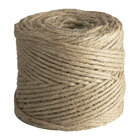
If you find yourself in a survival situation, you probably won't have a big ball of twine with you. In this case it could be helpful if you know how to make your own emergency cordage. Most of us don't have the knowledge, skill, or tools to spin our own yarn or ropes, but in an emergency you might make due with vines, weeds, or long grasses, which can be useful for tying sticks together to make a shelter. It is possible to make string or rope from smaller fibers, but it is time consuming and not something most of us would be able to accomplish in a survival situation without a lot of practice beforehand. Here is a link for How To Make Your Own Rope. They make it sound pretty easy, but I wouldn't want to bet my life on this skill without having practiced it first. Having a ball of twine in my rig or my pack would be a LOT easier and faster!
You can use twine or other cordage to bind sticks together to make a shelter and to create camp furniture. You will also find it handy for tying up sleeping bags, sleeping pads, tents, etc to keep them from unrolling. You will probably use it for tying loose objects onto your pack or maybe just your belt when you need to keep them handy.
If you're going to be successful using twine or any other type of cordage, you'll need to have some knowledge and skill tying knots. Most of the basic knots you will find useful are the same ones taught to Boy Scouts, so you could find information on how to tie them in a Boy Scout manual. Or you can find lots of good instructions and videos on the web. Here is a link to instructions for many popular Boy Scout knots. You may be surprised by how many different kinds of knots there are -- way to many for me to delineate here. There are different knots for different uses. For example, you use a different kind of knot to connect two ropes together depending on whether they are the same or different diameters. One of the most commonly used knots is the square knot. It is easy to tie and holds very well. Another very common knot is known as the "granny knot". It is something a lot of novices end up tying when first trying to tie a square knot and do it wrong. You want to avoid using a granny knot because they don't hold very well. Take the time to learn the right way to tie knots and to learn some of the kinds of knots you may need to use. If you are tent camping or using awnings where you need guy ropes, you will want to learn how to tie a taut line hitch. This knot holds well but allows you to adjust the tension as needed to keep your tent or awning tight. Taut line hitches or a variation called a "truckers haul" or "truckers knot" are useful for tying down OHVs, tents, awnings, tarps, etc. It not only is easy to tie and untie and easy to adjust, it works a little like a block and tackle to give you a mechanical advantage to pull things tight. I have seen variations of ways to tie this knot but they all yield the same results: easy to tie and untie, secure, easy to adjust, and a good way to pull the rope tight. Here are some of my favorite knots for camping and sailing.
Tie one on!

This comment has been removed by a blog administrator.
ReplyDelete